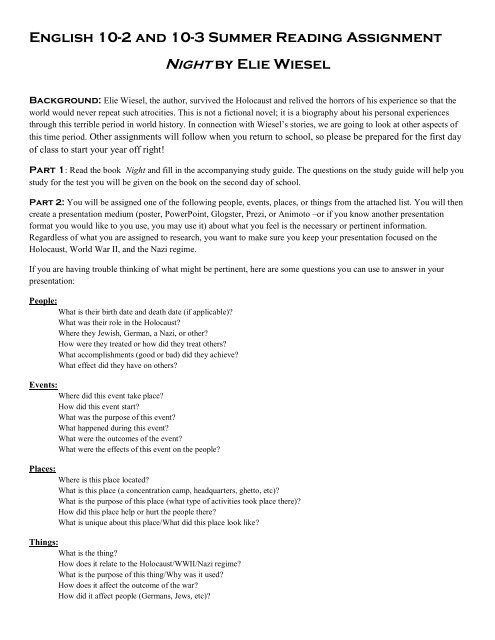Create successful ePaper yourself
Turn your PDF publications into a flip-book with our unique Google optimized e-Paper software.
English <strong>10</strong>-2 <strong>and</strong> <strong>10</strong>-3 <strong>Summer</strong> <strong>Reading</strong> Assignment<br />
Night by Elie Wiesel<br />
Background: Elie Wiesel, the author, survived the Holocaust <strong>and</strong> relived the horrors of his experience so that the<br />
world would never repeat such atrocities. This is not a fictional novel; it is a biography about his personal experiences<br />
through this terrible period in world history. In connection with Wiesel’s stories, we are going to look at other aspects of<br />
this time period. Other assignments will follow when you return to school, so please be prepared for the first day<br />
of class to start your year off right!<br />
Part 1: Read the book Night <strong>and</strong> fill in the accompanying study guide. The questions on the study guide will help you<br />
study for the test you will be given on the book on the second day of school.<br />
Part 2: You will be assigned one of the following people, events, places, or things from the attached list. You will then<br />
create a presentation medium (poster, PowerPoint, Glogster, Prezi, or Animoto –or if you know another presentation<br />
format you would like to you use, you may use it) about what you feel is the necessary or pertinent information.<br />
Regardless of what you are assigned to research, you want to make sure you keep your presentation focused on the<br />
Holocaust, World War II, <strong>and</strong> the Nazi regime.<br />
If you are having trouble thinking of what might be pertinent, here are some questions you can use to answer in your<br />
presentation:<br />
People:<br />
What is their birth date <strong>and</strong> death date (if applicable)?<br />
What was their role in the Holocaust?<br />
Where they Jewish, German, a Nazi, or other?<br />
How were they treated or how did they treat others?<br />
What accomplishments (good or bad) did they achieve?<br />
What effect did they have on others?<br />
Events:<br />
Where did this event take place?<br />
How did this event start?<br />
What was the purpose of this event?<br />
What happened during this event?<br />
What were the outcomes of the event?<br />
What were the effects of this event on the people?<br />
Places:<br />
Where is this place located?<br />
What is this place (a concentration camp, headquarters, ghetto, etc)?<br />
What is the purpose of this place (what type of activities took place there)?<br />
How did this place help or hurt the people there?<br />
What is unique about this place/What did this place look like?<br />
Things:<br />
What is the thing?<br />
How does it relate to the Holocaust/WWII/Nazi regime?<br />
What is the purpose of this thing/Why was it used?<br />
How does it affect the outcome of the war?<br />
How did it affect people (Germans, Jews, etc)?
Your presentation should be between 2-5 minutes. If you use Animoto, you will need to also create another visual aid, as<br />
only their 30 second videos are free to create. When you return to school, you will present this information to the class. Be<br />
ready to turn this assignment in on the FIRST day of school.<br />
You will need to use at least 2 valid <strong>and</strong> reliable sources to support your information. One source will need to be the<br />
United States Holocaust Memorial Museum website: www. ushmm.org. The other website/book source you use is up to<br />
you. In order for the source to be valid, it needs to have an author whose credentials are specific to the Holocaust <strong>and</strong>/or<br />
the time period <strong>and</strong> a copyright date.<br />
You will need to compile a Works Cited page with the two or more VALID sources you used.<br />
Works Cited<br />
1. Works Cited information is on a separate page at the end of your project.<br />
2. Use 12 point Times New Roman font<br />
3. Have 1” margins around<br />
4. Place in alphabetical order<br />
5. At the top of the page <strong>and</strong> placed in the center, label this page: Works Cited<br />
6. Have at least 2 VALID sources<br />
7. Double space between different entries, but single space if the same entry is on more than one line<br />
8. If an entry does go on the second line, use a hanging indent (indent the second line)<br />
9. DO NOT number or label your entries.<br />
Citing a page on a website:<br />
Author last name, first name. “Article Name.” Title of the Website. Name of the institution/organization affiliated with the<br />
site, date of creation or update. Medium of publication (web). Date of access in military format (day month year).<br />
Citing a book:<br />
Author last name, first name. Title of Book. Place of publication; Publisher, Year of Publication. Medium of publication<br />
(i.e. Print).<br />
Citing a chapter in a book:<br />
Author last name, first name. “Article Title.” Title of Book. Edition. Editor’s name(s). Place of Publication: Publisher,<br />
Year. Page range of entry. Medium of publication.<br />
Works Cited<br />
Gleick, James. Chaos: Making a New Science. New York: Penguin, 1987. Print.<br />
“Wages." U.S. Bureau of Labor Statistics. U.S. Department of Labor, Feb.-Mar.<br />
20<strong>10</strong>. Web. 04 Feb. 2011. .<br />
“Education.” DISCOVER Program. ACT. New York, NY: ACT, 2001. Print.
Presentation Topics<br />
People<br />
Adolf Hitler<br />
Heinrich Himmler<br />
Alfred Jodl<br />
Franklin Delano Roosevelt (in relation to WWII)<br />
Hermann Goering<br />
Josef Mengele<br />
Aron <strong>and</strong> Lisa Derman<br />
Blanka Rothschild<br />
Norman Salsitz<br />
Regina Gelb<br />
Thomas Buergenthal<br />
Simon Wiesenthal<br />
Wilhelm Keitel<br />
Jakob Blankitny<br />
Irene (Blasz) Csillag<br />
Miriam (Rot) Eshel<br />
Haya <strong>and</strong> Manya Friedman<br />
Mara Ginic<br />
Miroslav (Fred) Grunwald<br />
Pieter (Peter) Kohnstam<br />
Joseph Moses Lang<br />
Heinz Raphael<br />
Barabara Rebhun<br />
Irene Safran<br />
Agnes (Mendelovits) Wohl<br />
Events<br />
Places<br />
Things<br />
Kristallnacht<br />
Nuremberg Race Laws<br />
Battle of the Bulge<br />
Final Solution<br />
German-Soviet Pact<br />
Kielce Pogrom<br />
Treblinka<br />
Jewish uprisings in camps<br />
Auschwitz<br />
Bergen-Belsen<br />
Buchenwald<br />
Dachau<br />
Lodz ghetto<br />
Gross-Rosen<br />
Sachsenhausen<br />
Sobibor<br />
Theresienstadt<br />
History of the Swastika<br />
Nazi Medical Experiments<br />
Nazi Propag<strong>and</strong>a<br />
Schutzstaffel (SS)
Name: __________________________________________________<br />
Score: ______/50<br />
Night <strong>Summer</strong> <strong>Reading</strong> Presentation<br />
Assignment Rubric<br />
Visual Aid<br />
25 points<br />
Colorful /5<br />
Creative /5<br />
Informative /5<br />
Focused /5<br />
Presentation<br />
20 points<br />
Good Eye Contact /4<br />
Doesn’t Just Read Off Visual Aid /4<br />
Easily Heard /4<br />
Seems Knowledgeable About Subject Matter /4<br />
Is Between 2-5 Minutes /4<br />
Works Cited<br />
5 points<br />
2 Valid, Reliable Sources /3<br />
Correctly Cited /2
Vocabulary/Important Terms<br />
Aryan: A term used by the Nazis to mean a Caucasian person of non-Jewish<br />
lineage.<br />
Dysentery: A disease characterized by severe diarrhea with passage of mucus<br />
<strong>and</strong> blood<br />
Gestapo: The Nazi German police force known for acts of terror<br />
Hasidic: A Jewish sect that emphasizes mysticism, prayer, <strong>and</strong> joy<br />
Kabala(Cabbala): Jewish mysticism studied by Jewish scholars<br />
Kapo: Nazi concentration camp prisoners who were given special privileges in<br />
return for supervising other prisoners<br />
Meister: German word for master<br />
Passover: An 8 day Jewish festival celebrating the deliverance of the Hebrews from slavery in Egypt<br />
Rabbi: A Jewish title of respect given to honored teachers <strong>and</strong> pastoral leaders<br />
Red Army: The Soviet Union army<br />
Rosh Hashanah: The Jewish New Year, which includes special prayers <strong>and</strong> religious rituals<br />
Sabbath: Saturday= the seventh day <strong>and</strong> the holy day of the Jewish week. There is supposed to be complete<br />
abstinence from work; it is set aside for worship <strong>and</strong> rest to honor the day God “rested” after creating the universe<br />
Synagogue: The meeting place for Jewish non-sacrificial worship<br />
Talmud: A book of detailed expositions <strong>and</strong> interpretations of Hebrew scriptures (Jewish law)<br />
Truncheon: A short stick; similar to a club carried by the police<br />
Yom Kippur: The holiest day in the Jewish calendar, the Day of Atonement, a day of fasting <strong>and</strong> prayer for<br />
forgiveness<br />
Zionism: Formerly a movement for reestablishment of a Jewish state; now a movement supporting the Jewish<br />
state of Israel<br />
Part 1<br />
1. Describe Moishe the Beadle.<br />
Name: _______________________________________________<br />
Night by Elie Wiesel<br />
Study Guide<br />
2. Why did Eliezer pray? Why did he cry when he prayed?<br />
3. Why do you think none of the people in the village, including Wiesel, believed Moishe when he returned?
4. Cite examples of how the Jewish citizens of Sighet began to lose their rights.<br />
5. What is a ghetto?<br />
6. Why did the citizens resist the truth, even when it was in front of them?<br />
7. Describe the conditions in the train (at the end of the chapter).<br />
Part 2<br />
1. Explain, “Our eyes were opened, but too late.” Where was the train at this point?<br />
2. What was foreshadowed by Madame Schacter’s nightmare? Do you think she is a madwoman or a prophet? Why?<br />
3. What did some of the passengers do to quiet Madame Schacter?<br />
4. Why do you believe the passengers silenced Madame Schacter?<br />
5. Where did the train finally stop?
Part 3<br />
1. When questioned by the SS Officers, why did Elie lie about his age <strong>and</strong> occupation?<br />
2. What was the horrifying sight that Elie at first disbelieved?<br />
3. Explain what Elie meant when he said, “Never shall I forget these flames which consumed my faith forever.”<br />
4. How had Elie changed in a short time?<br />
5. What was Elie’s first impression of Auschwitz after leaving Birkenau?<br />
6. What was the “compulsory formality” at the entrance to all camps?<br />
7. What sort of identification was used on the prisoners?<br />
8. Why was the prisoner in charge of Elie’s block removed from the position?<br />
9. What were the prisoners’ rations at each meal?<br />
<strong>10</strong>. What was Bela Katz forced to do once he was chosen for his strength?
Part 4<br />
1. What were the objectives of the medical examinations?<br />
2. Why were the Jewish musicians not allowed to play music by Beethoven?<br />
3. Describe one of Idek’s bouts of madness?<br />
4. How did Elie initially avoid losing his gold crown?<br />
5. Whom did Elie meet years later on the Paris Metro?<br />
6. What happened when Elie refused to give his crown to Franek? What was the end result?<br />
7. Describe the scene with the soup cauldrons.<br />
8. During one of the preliminary “ceremonies” for a hanging, what did Juliek whisper to Elie? What does this<br />
suggest?<br />
9. During one hanging, Elie <strong>and</strong> the other prisoners cried. What made this hanging different from the others?
Part 5<br />
1. Why didn’t Elie fast on Yom Kippur?<br />
2. What advice was Elie given to pass the selection process?<br />
3. How did Elie’s father respond when he learned his name had been written down?<br />
4. What did Akiba Drumer ask the others to do for him? Did they do it?<br />
5. Why was Elie placed in the hospital?<br />
6. Why was the camp to be evacuated? What did Elie learn of the fate of those who stayed behind in the hospital?<br />
Part 6<br />
1. What happened to anyone who could not keep up with the march?<br />
2. How did Zalman die?<br />
3. What horrible realization did Elie come to concerning Rabbi Eliahou <strong>and</strong> his son? How did Elie respond to this?<br />
4. What was Juliek’s last act?
5. How did Elie help his father when the selection was made?<br />
Part 7<br />
1. How did Elie again help his father when they were on the train?<br />
2. Describe the scene Elie witnessed between the father <strong>and</strong> son?<br />
3. How many got out of the wagon? Where had they arrived?<br />
Part 8<br />
1. Explain how the father/son roles had been reversed between Elie <strong>and</strong> his father.<br />
2. Why was Elie’s father being beaten?<br />
3. What did Elie think of the advice given to him by the head of the block?<br />
Part 9<br />
1. What happened on April 5 th ?<br />
2. What was the resistance movement?
3. What did they do?<br />
4. What did the prisoners do when they were freed?<br />
Themes: Write down examples of these themes as they are shown in the novel. Give a few examples where they are<br />
present.<br />
1. Remembrance <strong>and</strong> Voice<br />
a. Example: Elie Wiesel writing the book provides a voice for all Holocaust survivors <strong>and</strong> a way to<br />
remember this time period <strong>and</strong> those who did not survive.<br />
2. Death<br />
3. Hopelessness<br />
4. Choiceless Choices<br />
5. Father/Son Relationship<br />
6. Dehumanization




